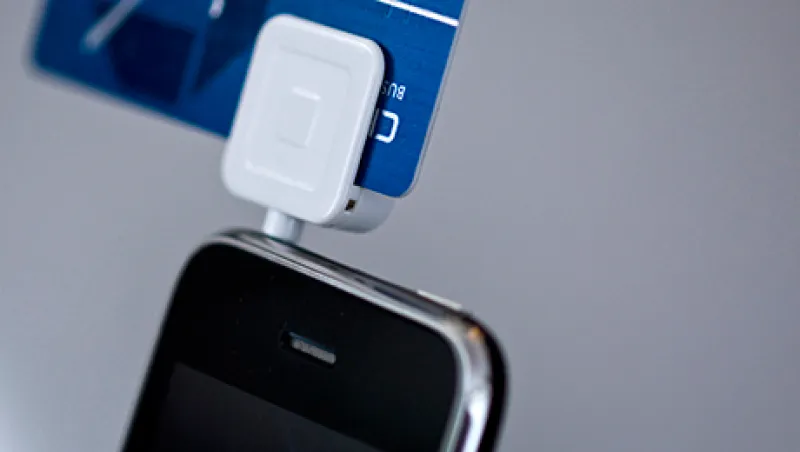Square Inc., the mobile payments company co-founded by Jack Dorsey of Twitter fame, has made plenty of hay in its six years of existence, racking up more than 2 million small-business users.
Now it is making plans for an initial public offering. But views are mixed as to how the San Francisco–based company and its main product, a square-shaped credit card reader that attaches to smartphones, will fare. Some analysts see great profit potential, but others view Square as just another company trying to make it in a crowded payment services market.
Technology-related IPOs have struggled recently. Payment-processing company First Data had to scale back its offering to $2.8 billion, from an initially projected range of up to $3.7 billion, and still saw its share price drop when it began trading last month.
On November 6 Square announced that it plans to issue 27 million shares at $11 to $13 a piece. It also has an option to provide another 4 million shares to underwriters. The offering would raise up to $403 million for the company, which would make it the seventh-largest IPO in the U.S. tech sector this year.
Square hopes for a valuation of $4.2 billion, which would represent a 30 percent decline from the $6 billion valuation of its last round of private funding in October 2014.
Rick Oglesby, senior analyst at Double Diamond Group, a research firm in Centennial, Colorado, believes Square’s glass is half full. Strong revenue growth is the backbone of any company, he says. “I think growth will overcome losses in the relatively short term.” The company has something of a moat around its niche, Oglesby says. “Right now, it is way ahead of its competitors in the space where Square focuses — small businesses down to individuals. With 2 million active sellers, Square has more than a tenfold advantage over its nearest competitors.”
Square is what’s known as a payment acquirer. Its square — hence the name — card-swipe attachment allows small businesses to accept credit card payments on a mobile device. It charges a 2.75 percent fee to merchants who use the service. The IPO filing showed that Square’s revenue soared 54 percent last year, to $850 million, but its losses widened 47 percent, to $154 million. For the first six months of 2015, Square generated revenue of $561 million and losses of $77 million.
The company has plenty of room to expand what it’s doing now, Oglesby says. And Square is already developing into lending and other areas. Ultimately, it can provide a full array of marketing services, possibly making Square into another Amazon, Oglesby says.
But Jim Sinegal, senior equity analyst at financial data and research firm Morningstar in Chicago, has a bit of a different take on the company. “There is a lot of competition there. Other companies have readers,” he says, citing PayPal and Intuit as examples. “Once something is plugged into an iPhone, there’s not a big way to differentiate yourself. There aren’t a lot of switching costs.” Someone selling goods at an art fair may be lured away by what they consider a better interface or software. “That makes it tough for Square,” Sinegal says.
One key issue for Square is that its CEO, Dorsey, has plenty of distractions from his other job — trying to reenergize Twitter. “At this point, it’s a hard sell to have one CEO for two fast-growing, somewhat troubled companies,” Sinegal says. “Square wouldn’t be easy for a CEO focusing all of his attention on it.” Sandy Shen, a research director for technology research firm Gartner in Shanghai, isn’t too worried, though, saying that “if Dorsey has a strong management team at both companies, there is no reason he can’t manage both at the same time.”
That C-suite issue aside, Oglesby thinks Square has strong fundamentals. “Having gone into small businesses puts Square in an underserved space,” he says. By broadening into lending, accounting and marketing, Square is creating a “horizon strategy to meet many business needs,” Oglesby maintains. The company’s products include Customer Engagement, a suite of customer relationship management tools encompassing e-mail marketing services, and it helps businesses to establish online stores. “The mother lode is using Square for marketing services,” says Oglesby. “If it helps customers generate revenue, that’s a very high value service. If Square can become the Amazon of on-site sellers, that’s where the market is.”
Last year the company also launched Square Capital, a lending program for small businesses, some 50,000 of which have borrowed roughly $300 million so far. Square also provides payroll and scheduling services and has launched a peer-to-peer payment service. These expansion plans don’t quite have Sinegal convinced, though.
“Square is diversifying into areas where there’s even more competition” than in payment acquisition, he says. “In small-business lending it’s competing against PayPal and banks. For peer-to-peer, I couldn’t begin to list the number of companies that are doing it.” And as for the idea of Square turning into an Amazon? “That’s very different,” Sinegal says. “The genius of Amazon is logistics, inserting itself into transactions and taking a piece. That would be the long-term ambition of PayPal too. But payment is a very tough business to disrupt.” There’s a network effect, as payment companies deal with banks, stores and customers, Sinegal says. “To get everyone on the same page isn’t an easy thing to do.” And at this point, Square has only merchants as customers, whereas PayPal has merchants and consumers.
So what is the outlook for a Square IPO? Oglesby is optimistic. “I don’t know how other investors will interpret this market, but in private valuations, Square has seen very strong valuations and growth,” Oglesby says. “I don’t see anything in the S-1 IPO prospectus to indicate that will change, particularly considering the conservative range that Square is expecting.”
Sinegal, as you may have guessed, has a different take. The recent difficulty of tech IPOs, particularly that of First Data, doesn’t bode well for Square, he says. First Data fell 4 percent in its first five days of trading before rebounding. “There is nothing to make me think Square would escape that,” Sinegal says. “I wouldn’t be surprised if its performance is a little lackluster.”






